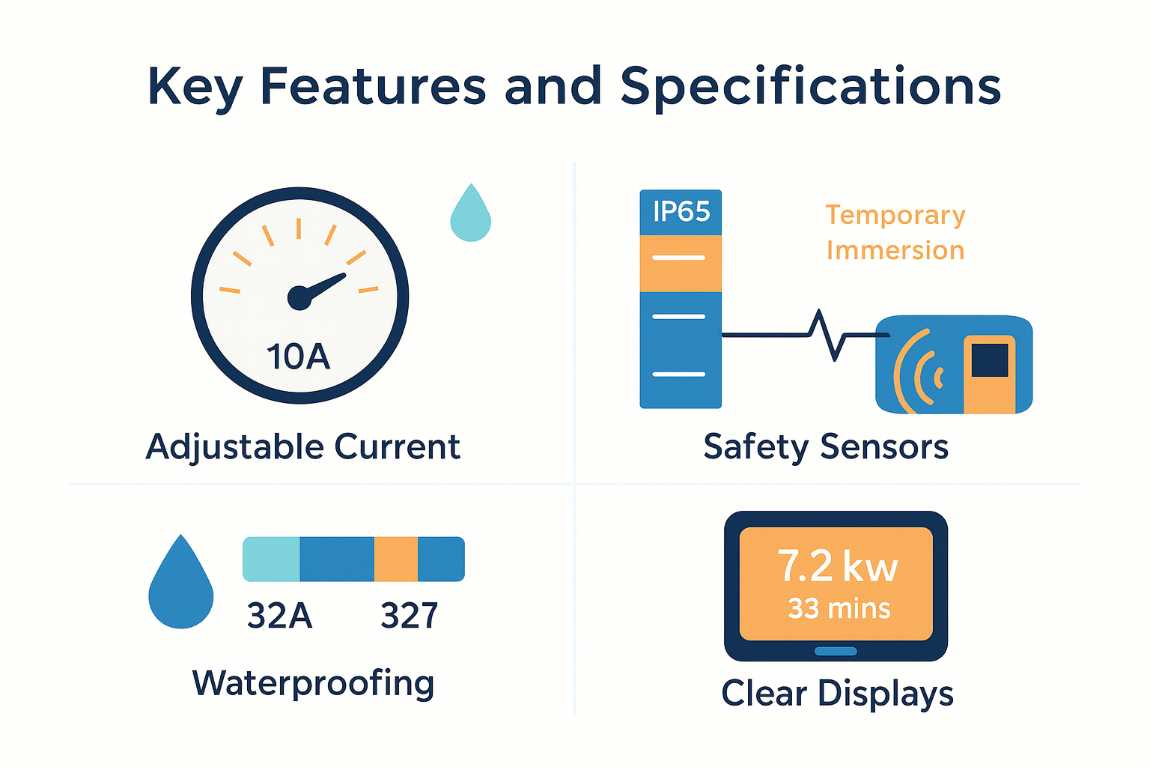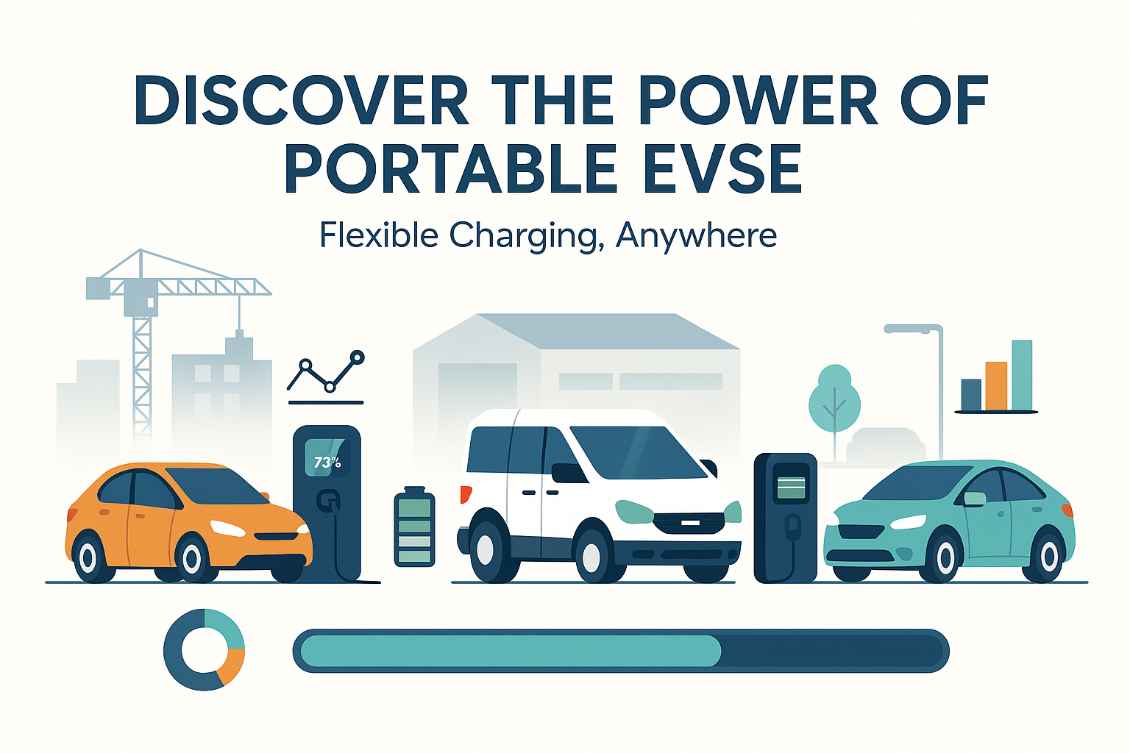Electric vehicles keep your operation moving only when they are charging efficiently. While fixed AC posts and DC fast chargers form the backbone of most networks, a portable electric-vehicle supply equipment (EVSE) unit gives you the agility to plug in wherever the vehicle is parked—on a depot forecourt, a construction site, or a temporary event hub. This guide unpacks today’s Portable EVSE landscape, focusing on the features and considerations that matter when you manage multiple vehicles or public charge points.
Overview of Portable EVSE Options
Portable EVSE covers a surprisingly wide power band. At the entry level you will find compact 3.6 kW units delivering roughly 15–20 km of range per hour, ideal for topping up pool cars or two-wheelers. Mid-range 7.2–7.4 kW models give a single-phase fleet van an overnight fill even when the shift finishes late. Higher-output 11 kW three-phase designs exist, yet the sweet spot for true grab-and-go convenience remains sub-8 kW.
Three examples illustrate today’s market without naming specific brands:
• A 2.4-inch-display charger with adjustable amperage lets drivers dial current down to match an older building circuit or ramp it up to 32 A when a 7 kW socket is free.
• A 7.4 kW IP65-rated unit encapsulates the electronics so rain, dust or the odd jet-wash will not cause downtime—crucial for outdoor depots and roadside assistance vans.
• A 3.6 kW charger integrating surge protection, PEN fault detection and a six-metre TPU cable shows how far safety engineering has advanced even in lightweight devices.
All three share a common theme: they deliver professional-grade functionality inside a portable package. As adoption rises, procurement teams must compare options on more than just power output.
Key Features and Specifications

Adjustable current and informative displays
Modern portable chargers rarely operate at a fixed amperage. Adjustable settings—typically 6 A, 10 A, 16 A and 32 A—let you squeeze maximum charge from whatever supply the driver finds. Pair that flexibility with a clear LCD or OLED screen and you gain real-time data on kilowatts delivered, session duration and internal temperature, helping you back-calculate energy costs per mile.
Waterproofing that matches the environment
Outdoor use demands an enclosure that resists dust and water ingress. You will see IP65, IP66 and occasionally IP67 markings. IP65 survives rain and low-pressure water jets; IP66 copes with high-pressure wash-downs often encountered in commercial yards. IP67 tolerates temporary immersion—overkill for most fleets, but reassuring for emergency-service operators relying on kit in flood conditions.
Integrated safety layers
Fleet-grade EVSE should detect over-voltage, over-current and over-temperature events within milliseconds, then shut down gracefully. Look for automatic cut-off on fault, Class B earth-leakage sensors that cover both AC and DC residual currents, and the option to disable the earthing pin when local regulations allow. When these functions sit onboard the portable unit, you do not rely on building wiring integrity alone.
Advanced Technology and Connectivity
App-based control is migrating rapidly from fixed wallboxes to portable chargers. A leading 7.2 kW model couples Wi-Fi and Bluetooth with a well-designed mobile app, enabling drivers to start, pause or schedule a session remotely. Over-the-air firmware updates future-proof the hardware—a single tap adds new charge profiles or national grid requirements years after purchase. Learn more about EV charging control software
RFID and automatic authentication
Where multiple drivers share chargers, RFID cards or Bluetooth proximity tokens authenticate sessions without fuss. The feature prevents unauthorised use and feeds accurate utilisation data to your back-office software.
Visual feedback
C-suite dashboards are valuable, yet the person plugging in wants instant reassurance that power is flowing. Multicolour LEDs and three-inch screens display status codes, current set-point and energy delivered in bright sunlight or at 3 a.m. yard checks.
Pulse Energy has observed a 40 % reduction in “charger not working” calls after fleets upgraded to models with clearer visual cues, highlighting the operational impact of good human-machine interfaces.
Portability and Ease of Use
Accessories define the daily experience. Look for:
Carry bags and holder clips
A rugged, padded bag protects the electronics when units rattle around in service vans. Integrated cable clips stop connectors dragging on dusty floors.
Wall brackets and five-metre leads
Mounting a portable EVSE on a temporary bracket keeps walkways clear, while a longer cable reaches awkward charge ports without moving the vehicle.
Lightweight design
Every kilogram counts when drivers lift equipment dozens of times a week. The lightest 3.6 kW units come in under 3.5 kg including cable; 7 kW variants hover around 5 kg—still manageable with one hand.
Operators sometimes forget to budget for these ancillary items, yet skipping a carry bag or spare holder inevitably shortens product life. Build them into your total cost of ownership from day one.
Safety and Reliability
Multiple layers keep personnel, vehicles and property safe:
Over-voltage and over-current protection
Grid fluctuations or underspecified extensions can spike voltage. Quality EVSE senses the anomaly and isolates power before damage occurs.
Type-B earth-leakage monitors
Unlike basic Type-A sensors, Type-B devices detect AC, pulsed and smooth DC leakage. That matters because DC faults can blind upstream RCDs, leaving circuits energised undetected.
On-board GFCI
Ground-fault circuit interrupters integrated inside the portable charger avoid dependence on building protection that may be absent in remote facilities.
Five-year warranties
Top-tier manufacturers now offer up to five years of cover, reflecting confidence in contactor cycles, cable strain relief and sealing gaskets. For a fleet that deploys chargers daily, that warranty horizon aligns with typical asset depreciation schedules.
Common pitfalls include ignoring certification marks such as CE, TUV or UL, or assuming that a domestic-grade plug will handle commercial duty. Always verify the test standard and match the connector class to your duty cycle. See best practices for maintaining an EV charger network.
Customisation and Design
Portable EVSE is no longer a black plastic box. Suppliers provide:
Brandable housings
Add your logo and corporate colours to reinforce brand presence when vehicles charge at public events. Custom moulding or over-printing achieves this without compromising ingress protection.
Temperature sensors with auto-recovery
Continuous thermal monitoring lets the charger derate current smoothly rather than trip offline. Auto-recovery logic restarts charging once temperatures stabilise, avoiding stranded vehicles.
Industry-standard packaging
Sturdy, recyclable cartons protect units in transit and streamline spare-parts logistics. Fleets shipping chargers between depots avoid damage claims and keep operations sustainable.
Design checklist
Define which panels you want in corporate colours, confirm UV-resistant coatings, prototype the layout for one-handed operation, validate in environmental chambers, then sign off for mass production. Skipping environmental validation is the fastest route to condensation failures or brittle plastics in the field.
Market Availability and Purchase Options
Regional supply matters when you manage dispersed depots. Northern markets often carry the 7.2 kW “swift-charge” models in stock, whereas southern hubs lean towards compact 3.5 kW units that pair well with residential wiring.
Payment flexibility
Suppliers typically accept credit terms, cash on delivery or telegraphic transfer. Large fleets sometimes negotiate cash-against-delivery to align with existing procurement workflows. Online marketplaces add pay-later or EMI facilities, useful for smaller operators smoothing capital expenditure.
Sample policy
Requesting a paid evaluation unit limits risk. Verify its performance across every use case—night shifts in freezing yards, daytime loads on generator-backed sites—before committing to a bulk order.
Delivery lead-times
Festive seasons and end-of-quarter surges can double shipping windows. Build a buffer into rollout schedules, especially if you plan to badge units with custom colours.
Frequently Asked Questions
Q1. What is portable EVSE?
Portable EVSE is a self-contained charging device that plugs into an existing electrical outlet, delivering controlled AC power to an electric vehicle without permanent installation. It combines cable, control electronics and safety mechanisms in a single unit you can carry between locations. Learn more about EVSE stations.
Q2. Is there a portable EV charger that delivers Level 2 charging?
Yes. Many 7.2 kW to 7.4 kW portable units operate on a 32 A single-phase supply, providing Level 2 performance comparable to a hard-wired wallbox while remaining fully transportable.
Q3. How do I integrate a portable charger into an existing fleet management platform?
Choose a model with Wi-Fi or Bluetooth connectivity and open API support, link it to the supplier’s cloud account, then map session data into your telematics or energy-management software via webhook or CSV export. See fleet EV charging software.
Q4. What are the main benefits of a portable unit over a fixed pedestal?
Portability lets you charge vehicles parked off-grid, re-allocate chargers to busy depots instantly and maintain service during infrastructure upgrades—all at a lower upfront cost than deploying additional fixed posts.
Q5. My charger trips off when it rains—what could be the issue?
Check the enclosure’s IP rating first. If it is below IP65, moisture ingress can trigger ground-fault protection. Upgrading to an IP66-rated unit or providing a weather shield usually resolves the problem.
Q6. How much should I budget for a fleet-grade portable EVSE?
Pricing for certified 7 kW units with app connectivity and advanced safety ranges from ₹15,000 to ₹20,000 in most Indian metros, rising for custom branding or five-year warranties. Factor accessories such as carry bags and wall brackets into the final figure.
Ready to enhance your EV charging experience with reliable portable EVSE solutions? Discover how Pulse Energy's innovative charging software can optimize your fleet's performance at https://pulseenergy.io.




.jpg)
.jpg)


